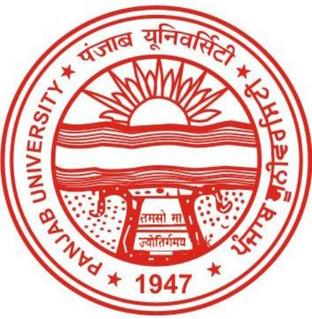
Panjab University Research Journal Social Sciences
Manuscript Submission Guidelines
- Manuscripts and all editorial correspondence, including comments on the contents of the journal, should be addressed to the Chief Editor, Panjab University Research Journal Social Sciences (PURJSS)
Name & E-mail address of the Chief Editor: Professor Deepak K. Singh, Department of Political Science, Panjab University, Chandigarh.
socialsciencejournal@pu.ac.in
Name & E-mail address of the Editor: Professor Latika Sharma, Department of Education, Panjab University, Chandigarh. socialsciencejournal@pu.ac.in - Contributors must provide their affiliations and complete postal and e-mail address with their papers.
- Papers submitted for consideration for publication in the Journal, should be original and not published elsewhere earlier.
- Contributors to PURJSS are advised to be careful as not to violate any provisions of the Copyright Act and the Rules made there under as regards the material/ maps used in articles or their sources and/or of the computer software used by them. The Journal is not responsible for any violations or lapses, in this regard, on the part of the contributors.
- The copy right of the papers, published in PURJSS rests solely with the Journal; any reproduction of the contents of the Journal will have to be done with written permission of the PURJSS.
- Contributions should be submitted electronically through email.
- Papers should not be more than 9,000 words. The word limit is inclusive of all notes, references tables, annexures and appendices.
- All articles must be accompanied by an abstract of 150-200 words. Notes should be numbered serially and presented as footnotes. Notes, other than website sources, must contain more than a mere reference.
- The Journal reserves its right to make stylistic changes or other editorial changes in the article(s) submitted and accepted for publication.
- PURJSS is a refereed journal and all manuscripts will be subjected to a double blind referral system.
- US spellings throughout; universal 'z' in '-ize' and 'ization' words.
- Single quotes throughout. Double quotes within single quotes. Spellings of words in quotations should not be changed. Quotations of 45 words or more should be separated from the text and indented with one line space above and below.
- Use 'twentieth century', '1990s'. Spell out numbers from one to ninety-nine, 100 and above to remain in figures. However, for exact measurements, use only figures (3 k., 9 per cent, not %). Use thousands and millions, not lakhs and crores.
- All contributions should be on A4 format, with 1.5 line spacing. Matter should be left-aligned, with a one-and-a half inch margin on the right and typed in 10-point font size in Times New Roman.
- Use of italics and diacriticals should be minimized, but consistent.
- Graphs, tables and charts prepared in MS Office (Word/Excel Format) or equivalent format are preferred.
- Tables and figures should be indicated by number separately (see Table 1), not by placement (see Table below). Present each table and figure on a separate sheet of paper, gathering them together at the end of the article.
- A consolidated alphabetical list of all books, articles, essays, theses and documents referred to (including any referred to in the tables, graphs and maps) should be provided at the end of the article. All articles books and theses should be listed in alphabetical order of author, giving the author's surname first followed by first name. If more than one publication by the same author is listed, the items should be given in chronological order. References should be embedded in text in the anthropological style. For example: (Sarkar, 1987: 145).
- Citations should be first alphabetical and then chronological, for example, '(Ahmed 1987; New York Times 2005; Sarkar 1987; Wignaraja 1960)'. The detailed style of referencing is as follows:
Article
Wang, Y. (2004). 'Offensive Realism and the Rise of China', Issues and Studies, 40(1): 173-201.
Book
Seth, S. (2013). Postcolonial Theory and International Relations: A Critical Introduction, London and New York: Routledge.
Edited Book
Shilliam, R., Anievas, A. and Manchanda, N. (eds) (2014). Race and Racism in International Relations: Confronting the Global Colour Line, London: Routledge.
Chapter in Edited Book
Mastanduno M. (2014) 'Realism and Asia' in Pekannen, S. M., Ravenhill, J. and Foot, R. (eds) The Oxford Handbook of the International Relations of Asia, Oxford: Oxford University Press: 25-44.
Internet Source
Thayer, B. A. (2006). 'In Defense of Primacy', The National Interest, available at http://nationalinterest.org/print/article/in-defense-of-primacy-1300 (accessed 19 August 2016).
Newspaper
Pradhan, B. (2006). 'India's Foreign Policy', Hindu, 26 June. New York Times (2005). 'US-NATO Alliance', 5 April (for news items).
Reports
Ghuman, R.S., Singh, S. and Brar, J.S. (2005). Unit Cost of Higher Education in Rural Punjab: A Case Study of Universities and their Affiliated Colleges, New Delhi. A Report submitted to the Association of Indian Universities (AIU).
Thesis
Arora, Sachna (2016). China and India in 'Global' Climate Change Negotiations: Domestic Imperatives and International Obligations. PhD thesis (unpublished) Chandigarh: Panjab University.
Book reviews must contain name of author and book reviewed, place of publication and publisher, year of publication, number of pages and price.
Submitted papers must be accompanied by (a) a declaration that it has not been previously published nor is being considered for publication elsewhere, and (b) a brief biographical sketch of the author giving current/recent institutional affiliation, major publications and present research interests.
Manuscripts not accepted for publication will not be returned to the authors(s). Please keep copies for your own record.
Contact Us:
Research Journal (Social Science)
Department of Political Science, Arts Block IV, Panjab University, Chandigarh - 160 014, India
Telephone: +91 172 254 1819